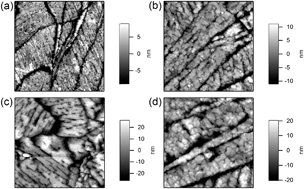Growth of thermally stable crystalline C60 films on flat-lying copper phthalocyanine†
Abstract
We observe thermally stable growth of fcc(111) films of fullerene-C60 on top of crystalline, flat-lying, CuPc film structures on graphite using combined grazing incidence wide-angle X-ray scattering and atomic force microscopy. Such a morphology is nearly ideal for bilayer films of C60/CuPc in solar cells. Very similar crystallinity and morphology is observed when varying the film thickness of either material from 5 nm up to more than 100 nm, suggesting that this advantageous solar cell morphology is not only robust, but may actually be preferred compared to the typical mounded fullerene morphology often seen on standing, edge-on aromatic film substrates. The large, ordered domains observed in both materials and the cofacial interface should greatly increase charge carrier mobility leading to increased fill factor. We envision that bilayer films, such as described here, grown on very high quality graphene as a transparent conducting electrode would simultaneously optimize crystallinity and molecular orientation for peak solar cell performance.


 Please wait while we load your content...
Please wait while we load your content...